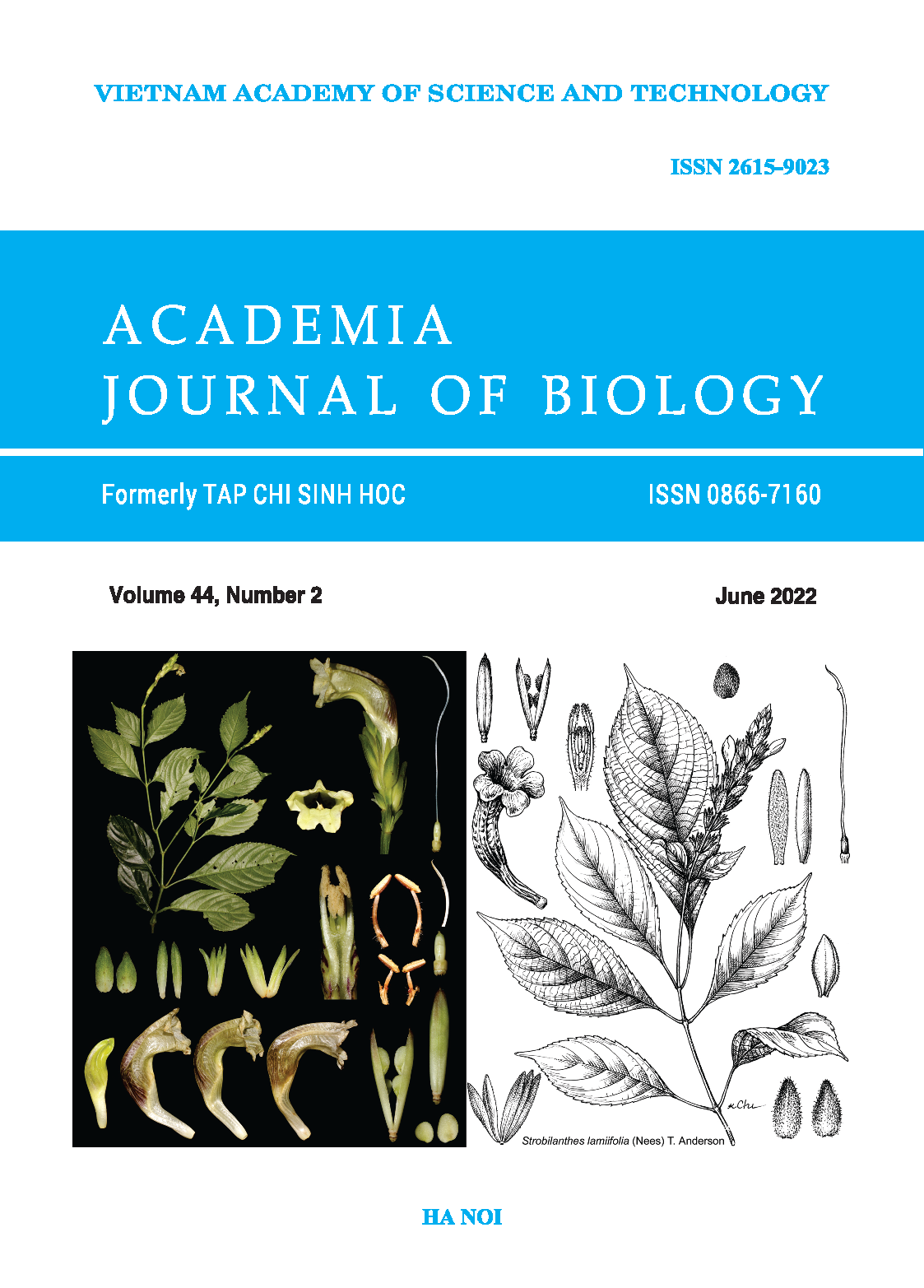Effects of augmentation with \(\textit{Bacillus}\) sp. DT1 on carbonfuran degradation and bacterial community in soil
Author affiliations
DOI:
https://doi.org/10.15625/2615-9023/16668Keywords:
Carbofuran, Bacillus sp. DT1, biodegradation, augmentationAbstract
Carbofuran is frequently applied to crop fields to combat insects globally causing serious environmental pollution. In this study, the enhanced degradation of carbofuran in soil by augmentation with Bacillus sp. DT1 was determined. The results showed that the augmentation with the bacterial strain increased the degradation by almost 30% compared to attenuation after 30 days at an initial concentration of 10 mg/kg dry soil. The half-life values of the insecticide were 41.6 and 17.9 days for attenuation and augmentation, respectively. Moreover, the augmentation with Bacillus sp. DT1 significantly increased sequence numbers of 16 S rRNA in soil compared to the initial stage. However, α-diversity indices, i.e., values of OTUs, ACE, Chao1 and Shannon showed no statistical differences in soil with and without the insecticide addition, with and without augmentation after 30 days. These results showed that carbofuran did not inhibit or stimulate the growth of soil bacteria at 10 mg/kg dry soil.
Downloads
References
Ambrosoli R., Nègre M., Gennari M., 1996. Indications of the occurrence of enhanced biodegradation of carbofuran in some Italian soils. Soil Biol Biochem, 28(12): 1749–1752.
Bano N., Musarrat J., 2004. Characterization of a novel carbofuran degrading Pseudomonas sp. with collateral biocontrol and plant growth promoting potential. FEMS Microbiol Lett, 231: 13–17.
Castro-Gutiérrez V., Masís-Mora M., Diez M. C., Tortella G. R., Rodríguez-Rodríguez C. E., 2017. Aging of biomixtures: Effects on carbofuran removal and microbial community structure. Chemosphere, 168: 418–425.
Colovic M. B., Krstic D. Z., Lazarevic-Pasti T. D., Bondzic A. M., Vasic V. M., 2013. Acetylcholinesterase inhibitors: pharmacology and toxicology. Current Neuropharmacology, 11(3): 315–335.
Das A. C., Chakravarty A., Sen G., Sukul P., Mukherjee D. A., 2005. Comparative study on the dissipation and microbial metabolism of organophosphate and carbamate insecticides in orchaqualf and fluvaquent soils of West Bengal. Chemosphere, 58(5): 579–584.
Duc H. D., 2022. Enhancement of carbofuran degradation by immobilized Bacillus sp. strain DT1. Environmental Engineering Research, 27(4): 210158–210150.
Farahani G. H. N., Sahid I. B., Zakaria Z., Kuntom A., Omar D., 2008. Study on the downward movement of carbofuran in two Malaysian soils. Bulletin of Environmental Contamination and Toxicology, 81(3): 294–298.
Gupta R. C., 1994. Carbofuran toxicity. Journal of Toxicology and Environmental Health, Part A, 43: 383–418.
Gupta J., Rathour R., Singh R., Thakur I. S., 2019. Production and characterization of extracellular polymeric substances (EPS) generated by a carbofuran degrading strain Cupriavidus sp. ISTL7. Bioresour Technol, 282: 417–424.
Ingham E. R., Coleman D. C., 1984. Effects of streptomycin, cycloheximide, fungizone, captan, carbofuran, cygon, and PCNB on soil microorganisms. Microbial Ecology, 10(4): 345–358.
Lewis K. A., Tzilivakis J., Warner D., Green A., 2016. An international database for pesticide risk assessments and management. Human and Ecological Risk Assessment, 22(4): 1050–1064.
Nguyen T. P., Helbling D. E., Bers K., Fida T. T., Wattiez R., Kohler H. P., Springael D., De Mot R., 2014. Genetic and metabolic analysis of the carbofuran catabolic pathway in Novosphingobium sp. KN65.2. Appl Microbiol Biotechnol, 98: 8235–8252.
Oanh N. T., Duc H. D., 2021. Anaerobic degradation of propanil in soil and sediment using mixed bacterial culture. Current Microbiology, 78(4): 1499–1508.
Otieno P. O., Lalah J. O., Virani M., Jondiko I. O., Schramm K. W., 2010. Soil and water contamination with carbofuran residues in agricultural farm lands in Kenya following the application of the technical formulation furadan. Journal of Environmental Science and Health, Part B, 45(2): 137–144.
Plangklang P., Reungsang A., 2009. Bioaugmentation of carbofuran residues in soil using Burkholderia cepacia PCL3 adsorbed on agricultural residues. Int Biodeter Biodegr, 63: 515–522.
Plangklang P., Reungsang A., 2009. Bioaugmentation of carbofuran residues in soil using Burkholderia cepacia PCL3 adsorbed on agricultural residues. Int Biodeter Biodegr, 63: 515–522.
Qu M., Li N., Li H., Yang T., Liu W., Yan Y., Feng X., Zhu D., 2018. Phytoextraction and biodegradation of atrazine by Myriophyllum spicatum and evaluation of bacterial communities involved in atrazine degradation in lake sediment. Chemosphere, 209: 439–448.
Ryeol P.M., Sunwoo L., Tae-Ho H., Byung-Tack, O., Shim J.H., Kim I.S., 2006. A New intermediate in the degradation of carbofuran by Sphingomonas sp. strain SB5. J Microbiol Biotechnol, 16:
–1310.
Trabue S. L., Ogram A. V., Ou L. T., 2001. Dynamics of carbofuran degrading microbial communities in soil during three successive annual applications of carbofuran. Soil Biology and Biochemistry, 33(1): 75–81
Zhou X., Shi X., Zhang L., Zhou Y., 2012. Effects of pesticide-contamination on population and activity of bacteria in purple paddy soil. Energy Procedia, 16: 284–289.
Downloads
Published
How to Cite
Issue
Section
License
Academia Journal of Biology (AJB) is an open-access and peer-reviewed journal. The articles published in the AJB are licensed under a Creative Commons Attribution-NonCommercial-NoDerivatives 4.0 International License (CC BY-NC-ND 4.0), which permits for immediate free access to the articles to read, download, copy, non-commercial use, distribution and reproduction in any medium, provided the work is properly cited (with a link to the formal publication through the relevant DOI), and without subscription charges or registration barriers. The full details of the CC BY-NC-ND 4.0 License are available at https://creativecommons.org/licenses/by-nc-nd/4.0/.












